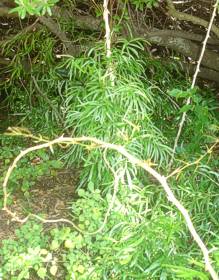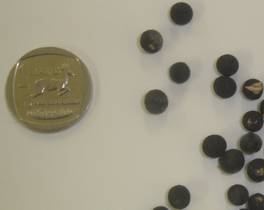Asparagus falcatus
Asparagus falcatus L.
Family: Asparagaceae
Common names: large forest asparagus, thorny creeper, sicklethorn, yellowwood asparagus (Eng.); doringtou (Afr.); imblekazana (isiZulu); ubulawu (isiXhosa)
Introduction
Asparagus falcatus is a robust thorny creeper that has attractive white flowers and red berries and will easily double as a safety hedge against unwanted visitors.

Description
Description
Asparagus falcatus is an evergreen climbing shrub, up to 7 m high. The roots of this plant form swollen tubers that resemble sweet potatoes. Older stems are light grey and have sharp, hard thorns that are curved backwards. The thorns serve as protection against predators as well as to grip onto the host plant to reach sunlight. Leaves are up to 80 mm long, sickle-shaped, shiny dark green with a prominent vein. It has small, white, fragrant flowers appearing from September to December. The fruit is a red berry. The seed is round, shiny and black.

Conservation Status
Status
Asparagus falcatus is currently neither threatened nor protected.
Distribution and habitat
Distribution description
Asparagus falcatus occurs from the Eastern Cape through KwaZulu-Natal into the Lowveld of South Africa, Swaziland and Mozambique. It is ideally suited to the forest and forest edges of these locations.
Derivation of name and historical aspects
History
The genus name of Asparagus is thought to be derived from the Greek, Asparagos, for the cultivated asparagus, and is possibly derived from a, meaning intensive, and sparassa, to tear, referring to the sharp spines of many species. The Latin word, falcatus, means sickle-shaped and alludes to the shape of the leaves.

Ecology
Ecology
With its tiny, very sweet-smelling flowers, its main pollinators are probably bees and other insects. The attractive red fruit attracts birds and they disperse the seed. Because this plant grows mainly in forest areas, the stem has adapted by producing thorns to help it to grip and climb through the canopies of trees to reach the sunlight.

Uses
Use
Asparagus falcatus makes an attractive potplant for a shady area, both indoors and out. It is also a plant that birds love to nest in as it provides perfect shelter and protection, so use it to attract birds to your garden. Its uncommon dark green foliage and uncommon stem are sometimes used in flower decorations. Also an African medicinal herb, the stems and leaves are pounded and used as a fresh poultice on swellings.

Growing Asparagus falcatus
Grow
Asparagus falcatus can easily be grown from seed, cuttings or by means of division. The fruit is harvested from the plant when it is red and soft; this is usually during May-July. A light scrub with water should remove the fleshy part of the fruit and expose the seed. Sow the seeds in spring or summer. The seeds germinate in 2-3 weeks. Older plants can be split and separated to produce more plants. Grow this plant to hang over a pergola or a fence. It can also be planted to serve as a protective hedge. It grows well in shade, but will tolerate partial sunlight. This is a fast-growing plant and can grow up to 50 mm per day. The plant grows best in moist, well-drained humus-peat soil. It can cope with a little soil; the ideal temperature is 21°C. It can be used successfully as a container plant, but remember to repot or trim the roots as it will break the pot if left to grow too big. The leaves are get sometimes eaten by various insects. To control the damage, occasionally spray the foliage with a pesticide.
References
- Nichols, G.D. 2008. Camouflage for forest wildlife. Farmer's Weekly, 98018: 86.
- Van Jaarsveld, E.J. 2006. Sekelblaar as heining. Die Burger, 14 February: 6.
- http://www.zimbabweflora.co.zw/speciesdata/species.php?species_id=11477- 13k.
- http:// www.ars-grin.gov/cgi-bin/npgs/html/taxon.
Credits
Bernard Martin Brown
Kirstenbosch National Botanical Garden
November 2008
Plant Attributes:
Plant Type: Climber, Scrambler
SA Distribution: Eastern Cape, KwaZulu-Natal, Limpopo, Mpumalanga
Soil type: Sandy, Clay, Loam
Flowering season: Spring, Early Summer
PH: Acid, Neutral
Flower colour: White
Aspect: Full Sun, Morning Sun (Semi Shade), Afternoon Sun (Semi Shade)
Gardening skill: Easy
Special Features:
Horticultural zones










Rate this article
Article well written and informative
Rate this plant
Is this an interesting plant?
Login to add your Comment
Back to topNot registered yet? Click here to register.